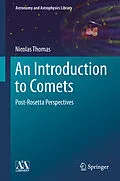Written by a leading expert on comets, this textbook is divided into seven main elements with a view to allowing advanced students to appreciate the interconnections between the different elements. The author opens with a brief introductory segment on the motivation for studying comets and the overall scope of the book. The first chapter describes fundamental aspects most usually addressed by ground-based observation. The author then looks at the basic physical phenomena in four separate chapters addressing the nucleus, the emitted gas, the emitted dust, and the solar wind interaction. Each chapter introduces the basic physics and chemistry but then new specific measurements by Rosetta instruments at comet Churyumov-Gerasimenko are brought in. A concerted effort has been made to distinguish between established fact and conjecture. Deviations and inconsistencies are brought out and their significance explained. Links to previous observations of comets Tempel 1, Wild 2, Hartley 2, Halley and others are made. The author then closes with three smaller chapters on related objects, the loss of comets, and prospects for future exploration.
This textbook includes over 275 graphics and figures - most of which are original. Thorough explanations and derivations are included throughout the chapters. The text is therefore designed to support MSc. students and new PhD students in the field wanting to gain a solid overview of the state-of-the-art.
Autorentext
Inhalt
Part I: Introduction and Scope.- Part II: Fundamentals of Comets.- Orbital Mechanics.- Sublimation of Ices.- The Nucleus.- Dust Emission from the Surface.- Gas Emission.- Plasma.- Part III: Recent Developments.- Surface Appearances.- Structural Strength.- Surface Processes.- Surface Composition.- Activity and Inhomogeneity.- Thermal Properties.- Seasonal Evolution.- Rotational Evolution.- Fracturing and Layering.- Internal Structure.- Dust Emission and Large Particles.- Dust to Gas Ratio.- Chemistry of the Outflow.- Dust Chemistry.- Part IV: The Cometary Lifecycle: Birth, Life and Death.- Models of Cometary Accretion.- Importance of Cometary Reservoirs.- The Importance of Impact and Sticking.- Initial Entry to the Inner Solar System.- Dead Comets.- Part V: Prospects for the Future.- Main Belt Comets.- Revisiting JFCs.- Appendices.
